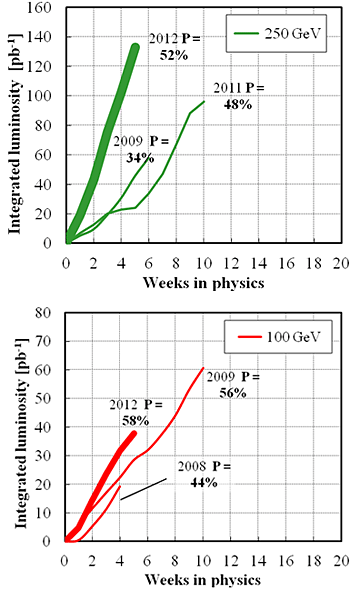Polarized Proton Operation in Run 12
August 13, 2012
By Vincent Schoefer

Vincent Schoefer
All particle colliders have to meet demanding goals for luminosity, the number of collisions per second they are producing, which requires colliding the most intense, tightly focused beams possible. RHIC, as the only polarized proton collider in the world, also has to meet the goal of maximizing the beam polarization – the degree to which this spins of all of the protons in the beam are pointing in the same direction. This is no easy feat since the magnetic fields required to keep the beams focused also have a tendency to tip the proton spins away from each other in a process called depolarizing resonance. During Run 12, we collided polarized protons at two different beam energies, 100 GeV and 255 GeV, each for about five weeks, setting records for luminosity and beam polarization at each energy.
The very intense, short proton bunches that we need to maximize the luminosity can become unstable during acceleration in RHIC. A 9 MHz RF acceleration system was commissioned in Run 11 and was available for operation on day one of Run 12 that allows for the acceleration of protons in much longer bunches. We can then shorten the bunches again once they are at top energy by ‘rebucketing’, a process of manipulating the bunches into a higher frequency 28 MHz RF system. This allowed us to raise the intensity of the proton bunches by 15% without causing any instabilities or beam loss. This, in addition to excellent accelerator reliability allowed us to exceed our Run 12 polarized proton luminosity expectations by 30% and 90% in the 100 and 255 GeV runs, respectively.

Integrated luminosities during recent polarized proton runs. Run 12 is in bold in each plot. ‘P’ is the beam polarization as measured by the atomic hydrogen jet.
In addition to increased luminosity, were were also able to realize record polarization during Run 12. Polarization during acceleration in the AGS and in RHIC is maintained largely by use of specialized helical dipole magnets called Siberian snakes. By carefully accounting for how the RHIC snake magnets affect the proton spins as the beam increases in energy, we were able to preserve more polarization on the RHIC ramp, particularly between 100 and 255 GeV. These adjustments, coupled with improvements to the polarized proton source made it possible to achieve average polarization of 58% and 52% in the 100 GeV and 255 GeV runs, respectively. These polarizations are as measured by the atomic hydrogen jet polarimeter and reflect the measurement averaged between the two rings, over the course of many RHIC stores.
RHIC is one of the most versatile accelerators in the world and this year we ran four different physics programs. In addition to 100 and 255 GeV protons, we collided 100 GeV/nucleon copper with 100 GeV/nucleon gold, and 96.4 GeV/nucleon uranium on uranium. In addition we had a two day low energy (2.5 GeV/nucleon) gold-gold test run. In order to meet (and even exceed) the collider goals for so many different program, two of them world firsts, it was imperative that the transitions between modes went as quickly as possible. Thanks to the very precise control of the beam afforded by our feedback systems [1], a whole host of tools we have built and the experience and dedication of our shift crews and system experts, each transition took only about four days. The transition between 100 GeV and 255 GeV polarized protons, for example, was smooth enough that the collider delivered the same integrated luminosity in the first week as it did on the best week of running in Run 11 (week 8).
The Run 12 polarized proton run was a great success on all fronts: luminosity, polarization and efficient operation. We are looking forward to the upcoming runs, when upgrades like a major polarized proton source upgrade and installation of the RHIC electron lenses will allow us to surpass even the excellent performance we have had this year.
[1] M. Minty, Precision Control of Beams in RHIC
About the author: Vincent Schoefer is an accelerator physicist at Brookhaven National Laboartory and was the CAD Run Coordinator for polarized protons in Run 12.
2012-3266 | INT/EXT | Newsroom









